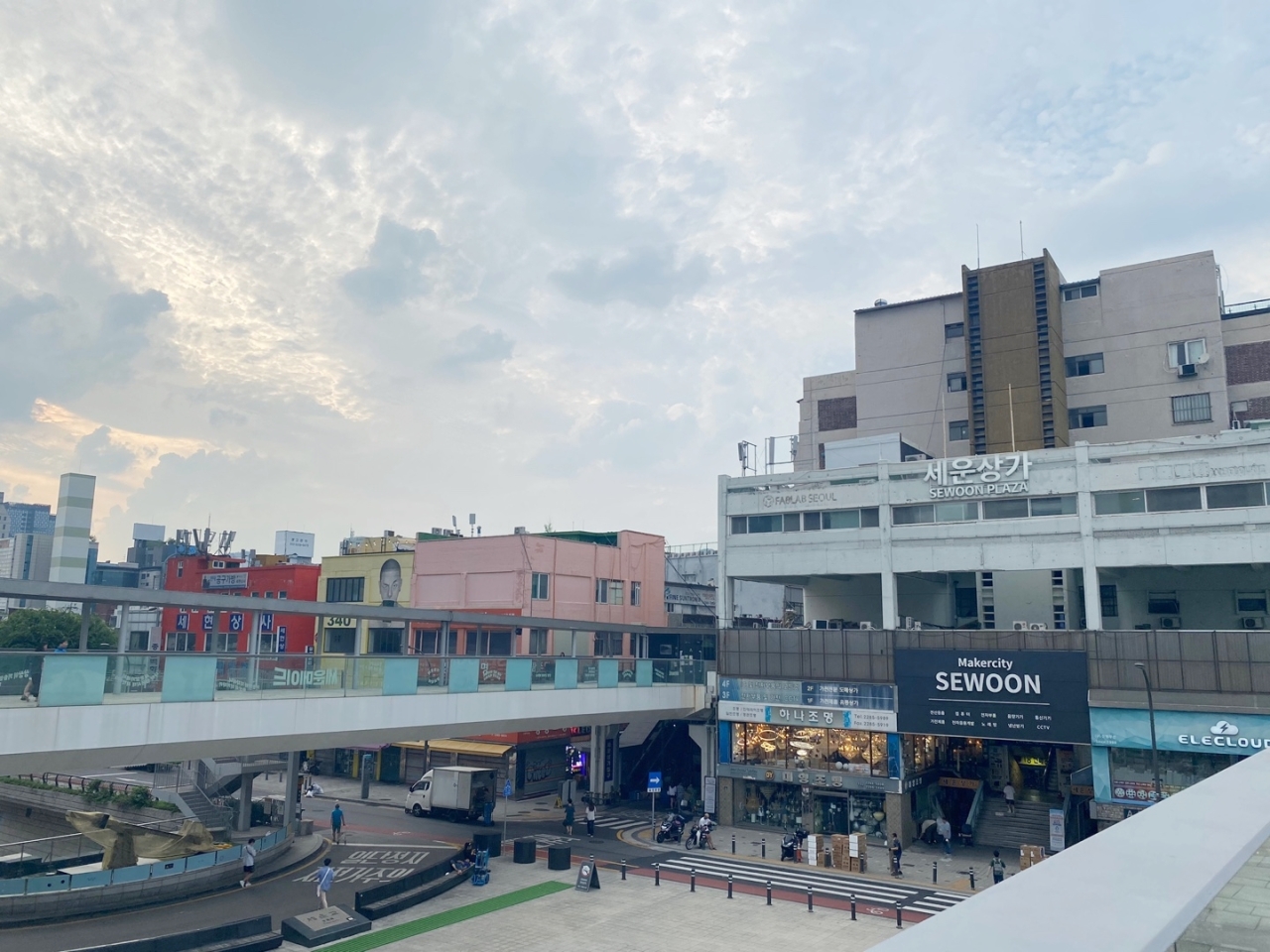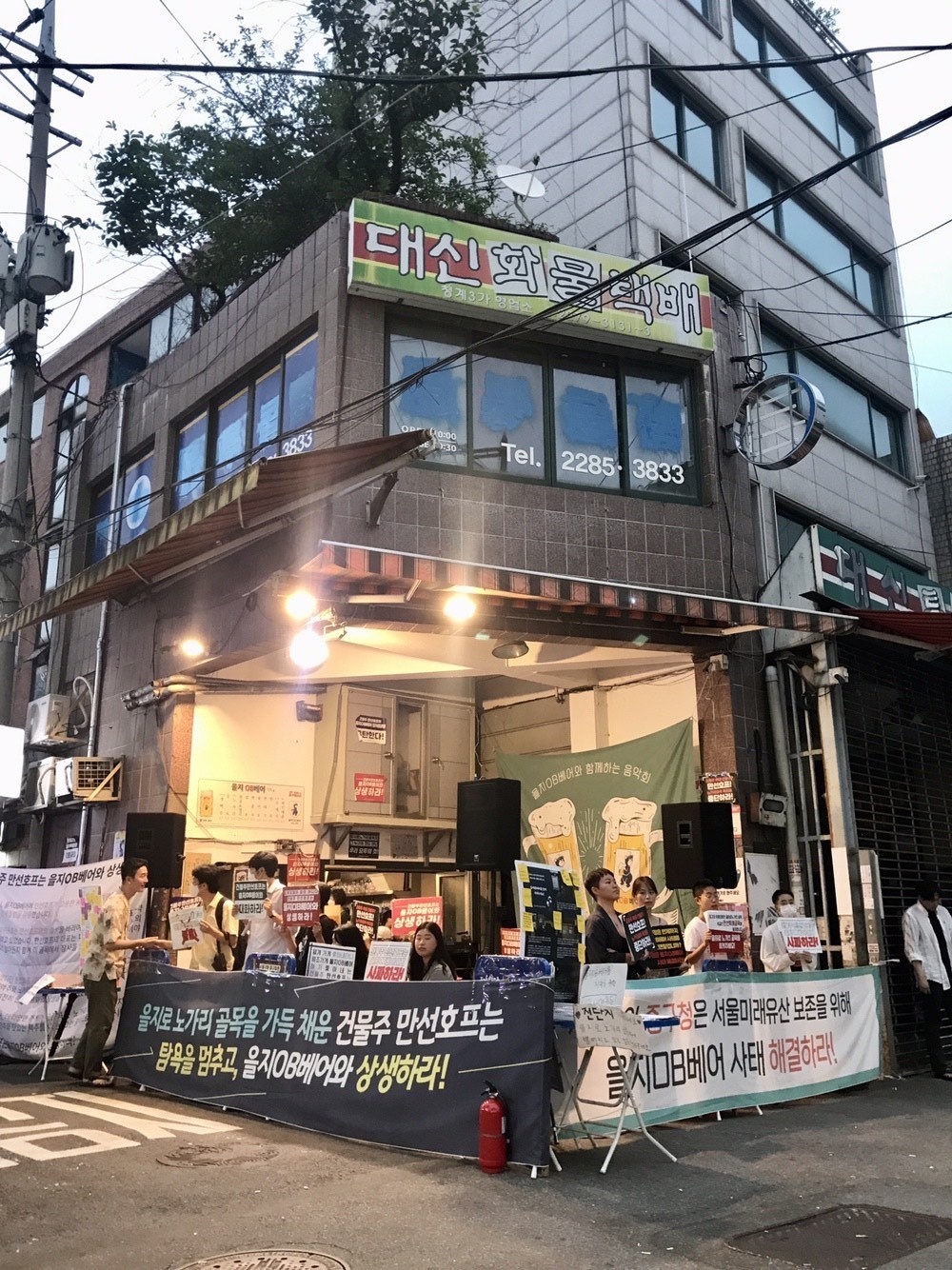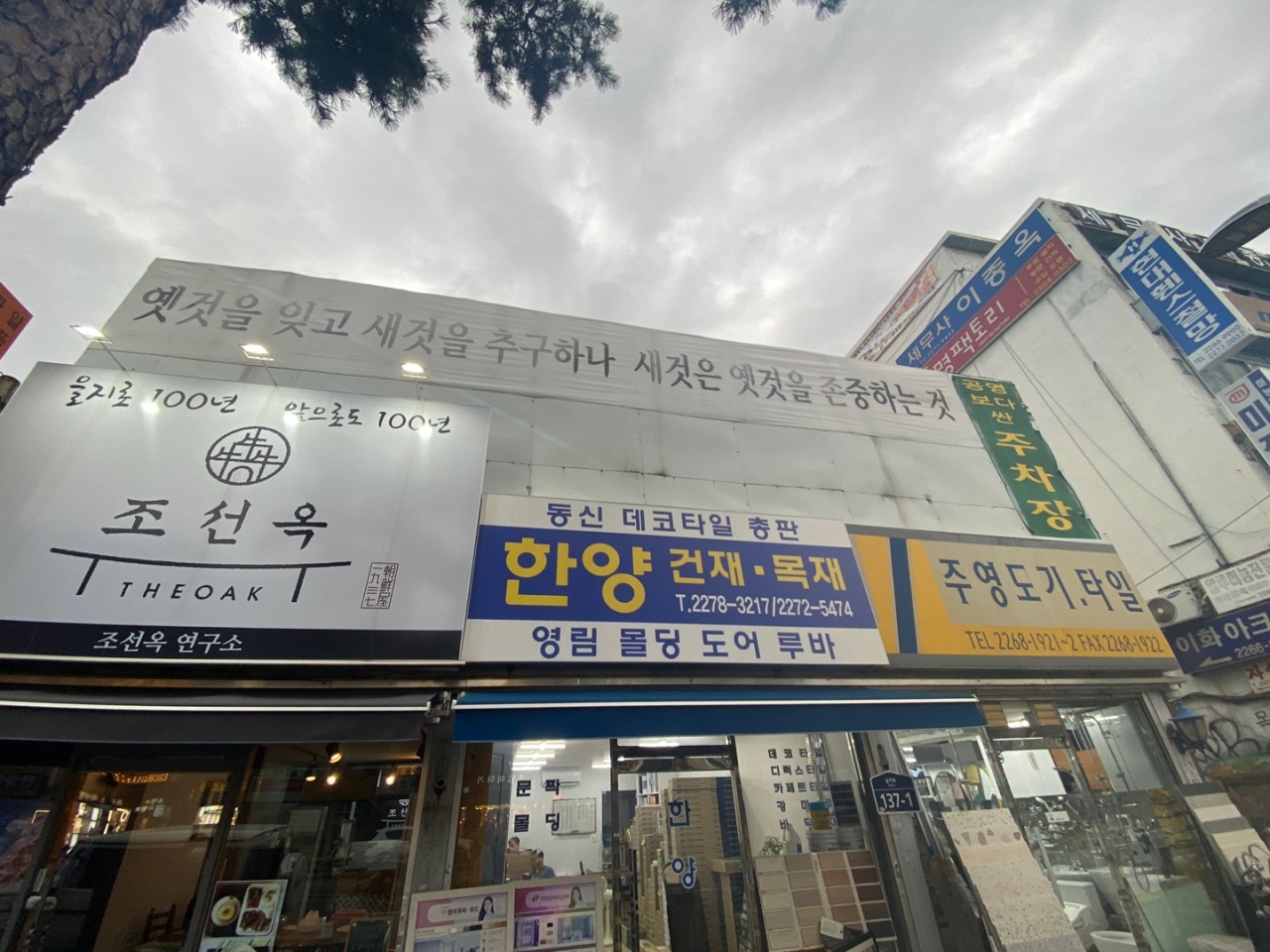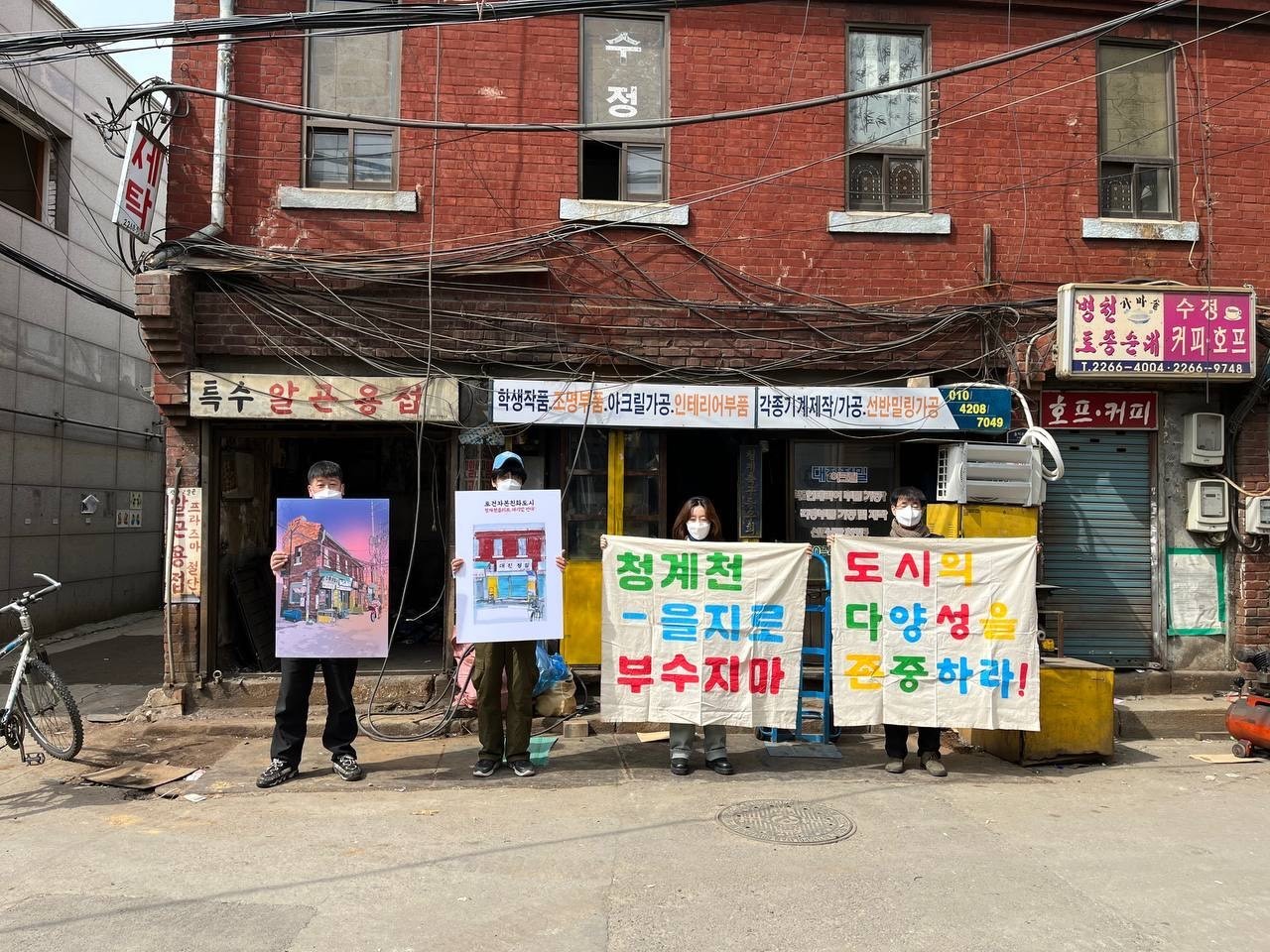
Sewoon Arcade is connected by pedestrian walkways. (Yim Hyun-su/The Korea Herald)
Earlier this year, a popular Pyongyang-style cold noodle restaurant in central Seoul closed down after 37 years. The closure of Eulji Myeonok came after a court ruled that a redevelopment project in the area should be allowed to go ahead following a yearslong legal battle, forcing the restaurant to leave the building it used to occupy.
Founded by the daughter of Korean War refugees, the restaurant was loved by customers across generations. People waited in line on its last day for a final taste.
In June, the Seoul city government announced that Chungjeong Apartment -- one of the oldest apartment buildings in South Korea -- would be torn down as part of its redevelopment plans. Painted green, the five-story building was built in the 1930s during Japanese colonial rule and is recorded as the first reinforced concrete apartment building in the country.
Both Eulji Myeonok and Chungjeong Apartment mark the latest in a series of places with cultural or historical significance that will be razed to the ground to make way for new ones.
And they are unlikely to be the last, as the Seoul city government has recently made a major U-turn on its urban planning policy. While the late Mayor Park Won-soon sought to preserve old buildings of special interest, his successor, Mayor Oh Se-hoon, won the election at a time housing was a major issue. He is seeking to ease regulations to allow more redevelopment projects and increase housing supply.
According to a general urban planning draft for 2040 released earlier this year, the city intends to do away with a 35-floor cap on residential buildings -- a rule that was introduced in 2014 under former Mayor Park.
“In downtown areas, there have been many regulations to preserve history and culture. But we want to ease some of these regulations when necessary, going from conservation regulations to overhauls,” said the Seoul Institute during a public hearing on the city’s new urban plans in June.

A banner at an anti-gentrification rally urges the local government to preserve the pub Eulji OB Bear that faced eviction. (Eulji OB Bear Joint Action Committee)
But while property investors and potential homebuyers have praised the move, some are concerned that the city could lose its charm and personality
Opposite Jongmyo, a Confucian shrine dedicated to the deceased kings and queens of Joseon and a UNESCO world heritage site, construction is underway for upscale apartment buildings. Already standing tall, photos of the buildings have gone viral on social media as many expressed disbelief that the view of the sky from the shrine is now blocked.
“Namsan is almost gone from the view,” architectural photographer Kim Yong-kwan said in a viral tweet in April. Perched atop the Namsan mountain is the N Seoul Tower, an iconic landmark in Seoul that can usually be seen unobstructed from anywhere in central Seoul.
Another tweet also expressed a similar concern. “I think this symbolizes many things. After construction, it will be difficult to see Namsan from Jongmyo.”
Sewoon ArcadeBuilt in 1976, Sewoon Arcade was the country’s first residential and commercial complex. At its peak between the '70s and '90s, it was home to many electronics and computer stores.
Decades after its heyday, many shops now sell industrial supplies and manufacturing equipment. And thanks to the city’s urban regeneration efforts, it now has pedestrian walkways that connect its buildings and a renovated rooftop -- a popular spot for Instagram photos. The 2021 Korean drama "Vincenzo" was also filmed at the arcade. Many old shops and restaurants are also located in the neighborhood.
But its future remains uncertain after Mayor Oh announced earlier this year plans to demolish the arcade and create a park as part of efforts to increase the amount of green space in the city.
From enacting relevant ordinances to purchasing the property, the megaproject will take years. There has already been chatter among small-business owners in the building.
“Where will we go if the city government kicks us out? We will have no place to go since this building will be turned into a park. I’m very much against the move,” said Kim Yong-ja, a 73-year-old business owner of a hardware store.

A banner near Sewoon Plaza reads, "People pursue new things while forgetting the old but what is new is respecting old things." (Yim Hyun-su/The Korea Herald)
The arcade let similar businesses like hers to be in close proximity of each other, helping forge a close community and business network. Having run her business for nearly 40 years, she said the closure of her shop would mean many job losses.
“My shop might look shoddy but we have a factory. What will happen to the factory workers?” Kim lamented.
Oh Myung-hee, a 56-year-old shop owner at Daelim Plaza, a nearby commercial building, balked at the plan to get rid of the elevated pedestrian walkways, a move Mayor Oh described as inevitable.
“They are getting rid of the pedestrian walkways that have been just laid out. It’s a waste of taxpayers’ money,” the shop owner said.
The first part of the pedestrian walkways was restored in 2017. The restoration project is estimated have cost around 100 billion won ($72 million).
“We should strive to create landmarks to be proud of, an electronics market here and something else there, protecting old places and have more diversity in the city," Oh Myung-hee said.
A 32-year-old barista surnamed Kang has been working at a cafe at Sewoon Arcade for two years. While he understands the need for more green space and efforts to address the housing shortage crisis in the city, he believes the city government should not give up on preserving history and the individual charms of local areas.
“I find these redevelopment projects that completely ignore the identity of local communities regretful,” said Kang.
“The housing crisis is a serious problem but there must be ways to address the problem while maintaining old neighborhoods.”
Shim Jae-choong, an 80-year-old shop owner who ran a business at Sewoon Arcade for some 40 years, however, believes the commercial complex’s time has come to an end.
“The redevelopment project must go ahead. You can see that businesses here are slow. They are open but they are essentially on hiatus,” Shim said.
When asked about concerns over disputes between landlords and old business owners, one Seoul city official said the city plans to seek measures to protect commercial property tenants from being evicted, though no details were shared.
“Our role as the public sector is to come up with guidelines and establishing standards that private companies in redevelopment projects will stick to,” the official said.
“But it is hard to spell out our measures as each redevelopment project area requires a different strategy."
Experts have also warned of the adverse impact of allowing developers to replace the city's architecture with utilitarian apartment buildings.
In a column published last year by daily newspaper the Hankyoreh, architect Yoo Hyun-joon said an emphasis on economic efficiency has resulted in the mass production of “identical-looking” apartments across the country.
As they all look the same, the properties have good liquidity and almost work like a currency. As a result, however, housing prices are the only value there is left, he said.
Yoo previously also argued that children who grew up in cookie-cutter apartments would lack creativity.
Efforts to save local heritageAgainst this backdrop, some are taking to the street to protect neighborhoods from changes that would harm local heritage and culture.
Ahn Kun-chul is a member of the Cheonggyecheon Anti Gentrification Alliance. The group holds rallies and cultural events, such as DJ parties, on the weekend outside what was once Eulji OB Bear, a pub a few blocks away from Sewoon Arcade. Their goal is to fight against gentrification that could see more places like Eulji OB Bear close in the future.

An anti-gentrification rally held by the Cheonggyecheon Anti Gentrification Alliance (Cheonggyecheon Anti Gentrification Alliance)
The old pub which opened in 1980 was selected as a Seoul Future Heritage site and a Long Lasting Small Business by the city government and the Ministry of SMEs and Startups. The property owner, who refused to lease the property to the pub, won a legal battle against Eulji OB Bear, forcing the pub to close down in April. The venue is now occupied by another pub that is part of a chain, Ahn said.
“At our rallies, people come and tell us they used to go drinking at Eulji OB Bear when they were young. It’s a highly valuable place with a lot of memories,” he said.
Ahn is worried Seoul's current redevelopment drive will hurt neighborhoods like the area around Sewoon Arcade as well as the city’s historical identity.
“As it is now, you have low-rise buildings in different shapes. Many houses have hanok interiors. Other countries would have strictly preserved and regulated such areas.
“The neighborhood is going to look like another Gangnam with high-rises," Ahn said.









